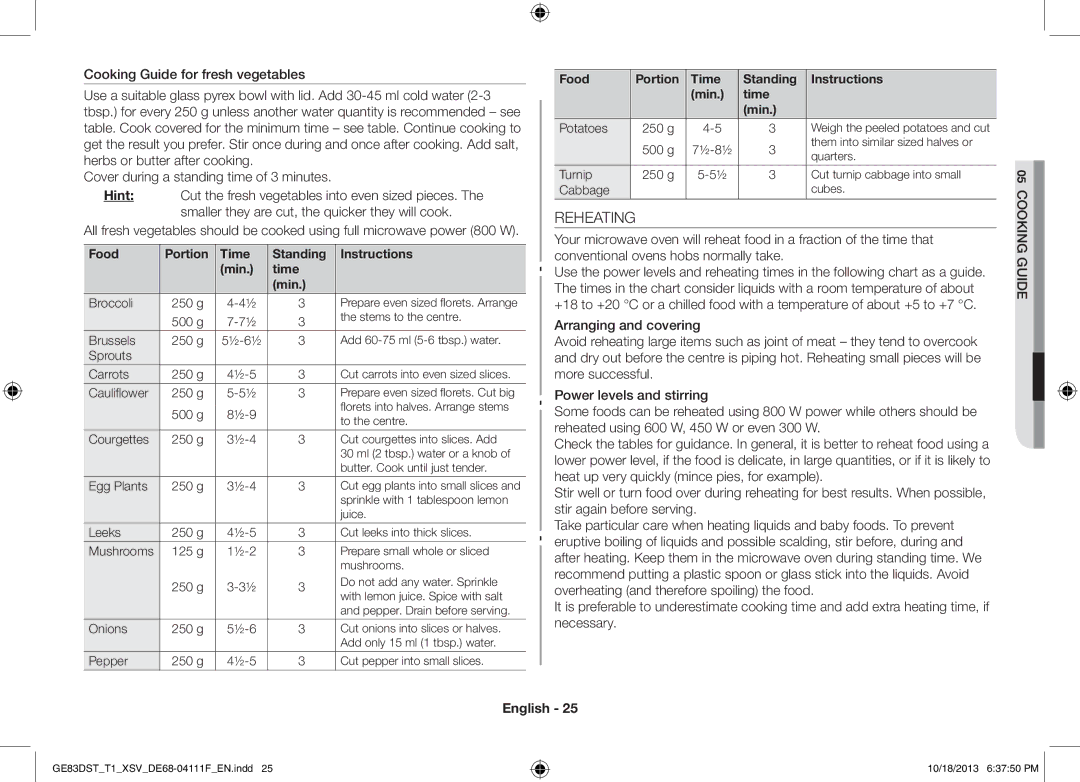
Cooking Guide for fresh vegetables
Use a suitable glass pyrex bowl with lid. Add
Cover during a standing time of 3 minutes.
Hint: Cut the fresh vegetables into even sized pieces. The smaller they are cut, the quicker they will cook.
All fresh vegetables should be cooked using full microwave power (800 W).
Food | Portion | Time | Standing | Instructions |
|
| (min.) | time |
|
|
|
| (min.) |
|
Broccoli | 250 g | 3 | Prepare even sized florets. Arrange | |
| 500 g | 3 | the stems to the centre. | |
|
| |||
Brussels | 250 g | 3 | Add | |
Sprouts |
|
|
|
|
Carrots | 250 g | 3 | Cut carrots into even sized slices. | |
Cauliflower | 250 g | 3 | Prepare even sized florets. Cut big | |
| 500 g |
| florets into halves. Arrange stems | |
|
| to the centre. | ||
|
|
|
| |
Courgettes | 250 g | 3 | Cut courgettes into slices. Add | |
|
|
|
| 30 ml (2 tbsp.) water or a knob of |
|
|
|
| butter. Cook until just tender. |
Egg Plants | 250 g | 3 | Cut egg plants into small slices and | |
|
|
|
| sprinkle with 1 tablespoon lemon |
|
|
|
| juice. |
Leeks | 250 g | 3 | Cut leeks into thick slices. | |
Mushrooms | 125 g | 3 | Prepare small whole or sliced | |
|
|
|
| mushrooms. |
| 250 g | 3 | Do not add any water. Sprinkle | |
| with lemon juice. Spice with salt | |||
|
|
|
| |
|
|
|
| and pepper. Drain before serving. |
|
|
|
|
|
Onions | 250 g | 3 | Cut onions into slices or halves. | |
|
|
|
| Add only 15 ml (1 tbsp.) water. |
Pepper | 250 g | 3 | Cut pepper into small slices. |
Food | Portion | Time | Standing | Instructions |
|
| (min.) | time |
|
|
|
| (min.) |
|
Potatoes | 250 g | 3 | Weigh the peeled potatoes and cut | |
| 500 g | 3 | them into similar sized halves or | |
| quarters. | |||
|
|
|
| |
Turnip | 250 g | 3 | Cut turnip cabbage into small | |
Cabbage |
|
|
| cubes. |
REHEATING
Your microwave oven will reheat food in a fraction of the time that conventional ovens hobs normally take.
Use the power levels and reheating times in the following chart as a guide. The times in the chart consider liquids with a room temperature of about +18 to +20 °C or a chilled food with a temperature of about +5 to +7 °C.
Arranging and covering
Avoid reheating large items such as joint of meat – they tend to overcook and dry out before the centre is piping hot. Reheating small pieces will be more successful.
Power levels and stirring
Some foods can be reheated using 800 W power while others should be reheated using 600 W, 450 W or even 300 W.
Check the tables for guidance. In general, it is better to reheat food using a lower power level, if the food is delicate, in large quantities, or if it is likely to heat up very quickly (mince pies, for example).
Stir well or turn food over during reheating for best results. When possible, stir again before serving.
Take particular care when heating liquids and baby foods. To prevent eruptive boiling of liquids and possible scalding, stir before, during and after heating. Keep them in the microwave oven during standing time. We recommend putting a plastic spoon or glass stick into the liquids. Avoid overheating (and therefore spoiling) the food.
It is preferable to underestimate cooking time and add extra heating time, if necessary.
05 COOKING GUIDE![]()
English - 25
10/18/2013 6:37:50 PM ![]()
